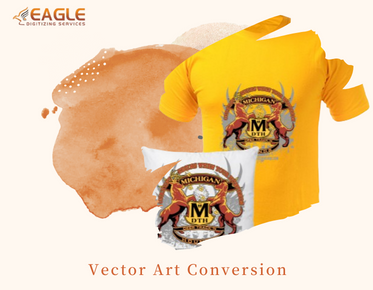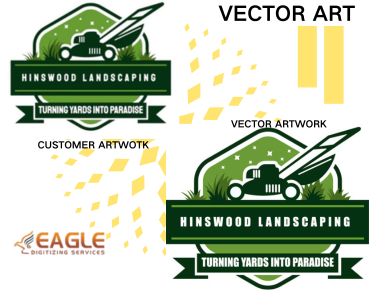Create Unique Patterns: Design Manipulation Using Vector Art for Embroidery
Embroidery is a timeless craft that combines artistry and craftsmanship. It transforms ordinary fabric into extraordinary pieces, each stitch telling a story. But in an age where digital innovation reigns supreme, vector art emerges as a revolutionary ally for embroidery design. By harnessing the power of vector graphics, artists can create intricate designs that maintain clarity and precision, regardless of size. This blog explores the enchanting world of vector art and its harmonious marriage with embroidery, providing insights into techniques that elevate your creations to new heights.
Why Vector Art is Ideal for Embroidery Design
Vector art, characterized by its use of paths and points rather than pixels, lends itself beautifully to embroidery. Each line and curve can be manipulated infinitely without sacrificing quality. This means that no matter how big or small the design, it retains its sharpness and definition. Additionally, vector files are smaller and more manageable, making them ideal for the intricate and often detailed work required in embroidery. With vector art, artists can work with confidence, knowing their designs will translate seamlessly onto fabric.
Getting Started: Tools You’ll Need
Essential Software for Creating Vector Art
Before diving into the world of vector art for embroidery, you'll need the right software at your fingertips. Programs like Adobe Illustrator and CorelDRAW are industry standards, offering a wealth of tools for crafting intricate designs. For those seeking free options, Inkscape is an excellent choice, packed with features that rival its paid counterparts. Regardless of your selection, ensure the software supports exporting to formats compatible with embroidery machines.
Recommended Hardware: Tablets and Printers for Embroidery
The right hardware is just as vital as software. A graphics tablet can significantly enhance your design experience, allowing for natural drawing and fine-tuned control over your creations. Brands like Wacom offer a range of tablets suited for all skill levels. Additionally, a reliable printer is essential for testing your designs. Look for a printer that can handle high-quality color outputs, as this will be invaluable for previewing your embroidery designs before they hit the fabric.
Setting Up Your Workspace for Maximum Creativity
Your workspace can greatly influence your creative flow. Aim for an organized, clutter-free environment that inspires creativity. Good lighting is crucial; natural light can enhance your mood and productivity, while adjustable task lighting is excellent for detail work. Surround yourself with inspiration—swatches of fabric, threads, and sketches of previous projects. A well-curated space will not only facilitate your design process but also ignite your imagination.
Creating Your Vector Art for Embroidery
Choosing the Right Design: Ideas and Inspiration
When embarking on your vector art journey for embroidery, selecting the right design is crucial. Look for inspiration in nature, architecture, or even your favorite patterns. Floral motifs, geometric shapes, and whimsical illustrations translate beautifully into embroidery. Take time to sketch your ideas, allowing your creativity to flow freely. Remember, the best designs are often those that resonate personally with the artist, as passion and enthusiasm breathe life into every stitch.
Basic Techniques for Drawing in Vector Software
Drawing in vector software can be a delightful experience. Begin with the Pen Tool, which allows you to create precise paths and shapes. Mastering this tool is essential; practice creating smooth curves and sharp angles. Use the Shape Tool for basic elements, and don't hesitate to combine different shapes to form complex designs. Experiment with layers to separate elements of your design, making adjustments easier. Over time, your confidence in the software will grow, and you’ll find your unique style emerging.
Utilizing Shapes and Lines: Building Your Design from Scratch
Shapes and lines are the building blocks of vector art. Start with basic forms and build upon them to create intricate designs. Use straight lines to outline your shapes and curves to add fluidity. Don’t be afraid to overlap elements; layering can create depth and interest in your embroidery design. By deconstructing complex images into simple shapes, you’ll develop a clearer understanding of how to manipulate them into cohesive designs.
Manipulating Your Design: Techniques and Tips
Resizing Without Losing Quality: The Power of Vectors
One of the most significant advantages of vector art is its ability to be resized without any loss of quality. Whether you need a small emblem or a grand mural, your vector design can adapt effortlessly. Utilize the transform tools in your software to resize your art while maintaining proportions. This flexibility ensures your designs remain visually stunning, regardless of their final application.
Changing Colors Effortlessly: Palette Adjustments for Embroidery
Adjusting colors in vector art is a breeze. Take advantage of the swatches panel in your software to experiment with different color palettes. Keep in mind that the colors you choose will affect the thread selection in your embroidery project. Test various combinations to find the perfect match, ensuring your final design harmonizes beautifully. Remember, color can evoke emotions—play with tones and shades to enhance the overall impact of your work.
Rotating and Flipping: Adding Variety to Your Design
Introducing rotation and flipping techniques can breathe new life into your designs. By rotating elements, you can create dynamic compositions that draw the viewer's eye. Flipping shapes can add balance and symmetry, making your artwork more visually appealing. Don't hesitate to explore these techniques; often, a simple rotation can transform a standard design into something remarkable.
Adding Details: Enhancing Your Vector Design
Incorporating Text: Choosing Fonts That Stitch Well
Text can significantly enhance your vector art, but not all fonts are created equal for embroidery. Choose fonts that are clear and legible at small sizes, avoiding overly intricate designs that may not stitch well. Sans-serif fonts often work best due to their clean lines. Experiment with different sizes and placements to ensure the text complements your design without overpowering it.
Adding Effects: Shadows, Gradients, and More
Effects can elevate your embroidery designs from good to spectacular. Shadows can add depth, making elements appear three-dimensional. Gradients can create smooth transitions between colors, adding richness to your artwork. However, keep in mind that some effects may not translate well to embroidery; test different approaches to see what works best with your chosen medium.
Layering Techniques: Creating Depth and Interest
Layering is a powerful technique that can bring your designs to life. Use layers to separate elements of your artwork, allowing for more complex compositions. Experiment with opacity and blending modes to achieve different effects. By strategically layering your designs, you can create depth and interest that captivate the viewer's attention.
Preparing Your Vector Art for Embroidery
Converting to the Right File Format: What You Need to Know
Once your design is complete, converting it to the correct file format is essential. Most embroidery machines require specific formats such as DST, PES, or EXP. Research your machine's requirements and export your vector art accordingly. This step ensures that your design translates accurately into the stitching process, preventing any unnecessary hiccups down the line.
Understanding Stitch Types: How to Prepare Your Design for Stitching
Learn about the various sorts of stitches, including running, fill, and satin. Each has unique characteristics that can affect the final appearance of your embroidery. When preparing your design, ensure that you select the appropriate stitch type for each element. Understanding how these stitches interact will help you create designs that are not only visually appealing but also structurally sound.
Setting Up Colors for Embroidery: Thread Matching Made Easy
Color selection is paramount when preparing your vector art for embroidery. Use thread color charts to match your digital colors with actual thread colors. This ensures that your final product looks as vibrant as you envisioned. Create a color key for your design, noting which thread colors correspond to which elements. This practice will streamline the stitching process and reduce the likelihood of errors.
Using Embroidery Software for Final Adjustments
Importing Your Vector Design into Embroidery Software
After preparing your vector art, it’s time to import it into your embroidery software. Most programs allow for seamless integration of vector files, making this step relatively straightforward. Open your embroidery software, navigate to the import function, and select your vector design. Once imported, check for any discrepancies in the design, ensuring everything appears as intended.
Adjusting Stitch Density: Ensuring a Flawless Finish
Stitch density plays a crucial role in the quality of your final product. Adjust the density settings in your embroidery software to achieve the desired texture and finish. Higher densities can lead to a more textured look but may increase the risk of thread breakage. Conversely, lower densities yield a lighter feel but may compromise detail. Striking the right balance is key to ensuring a flawless finish.
Previewing Your Design: How to Simulate the Finished Product
Before hitting the "start" button on your embroidery machine, take advantage of the preview feature in your software. This allows you to simulate the stitching process, providing a clear view of how your design will appear once complete. Look for any potential issues or adjustments that may need to be made. This step is vital for catching mistakes early and ensuring your design will look its best when stitched.
Testing Your Design
Creating a Sample Stitch Out: Why It’s Essential
Testing your design with a sample stitch-out is a critical step in the embroidery process. By running a small test on a similar fabric, you can evaluate how your design translates from digital to physical form. This allows you to assess stitch quality, density, and color accuracy. A sample stitch-out can save you time and materials by identifying any adjustments needed before the final run.
Troubleshooting Common Issues: Fixing Mistakes Before the Final Run
Despite thorough preparation, issues can still arise during the testing phase. Common problems include thread tension, misalignment, and color discrepancies. Determine the underlying causes of these problems and implement the required fixes. Whether it's recalibrating your machine or tweaking your design, addressing problems early can save you significant frustration later.
Evaluating Stitch Quality: What to Look For
After completing your sample stitch-out, examine the stitch quality carefully. Look for clean, even stitches without any fraying or thread breakage. Assess the color vibrancy and overall appearance of the design. Take notes on any areas that may need improvement before proceeding to your final run, ensuring your embroidery meets the highest standards.
As technology continues to evolve, the future of embroidery design promises even more exciting innovations. Vector artwork will undoubtedly play a central role, enabling artists to create intricate designs with ease. Embrace this ever-changing landscape; who knows what possibilities await? With vector art and embroidery combined, the only limit is your creativity. Keep designing, keep stitching, and let your artistry flourish in every thread.


.png)
